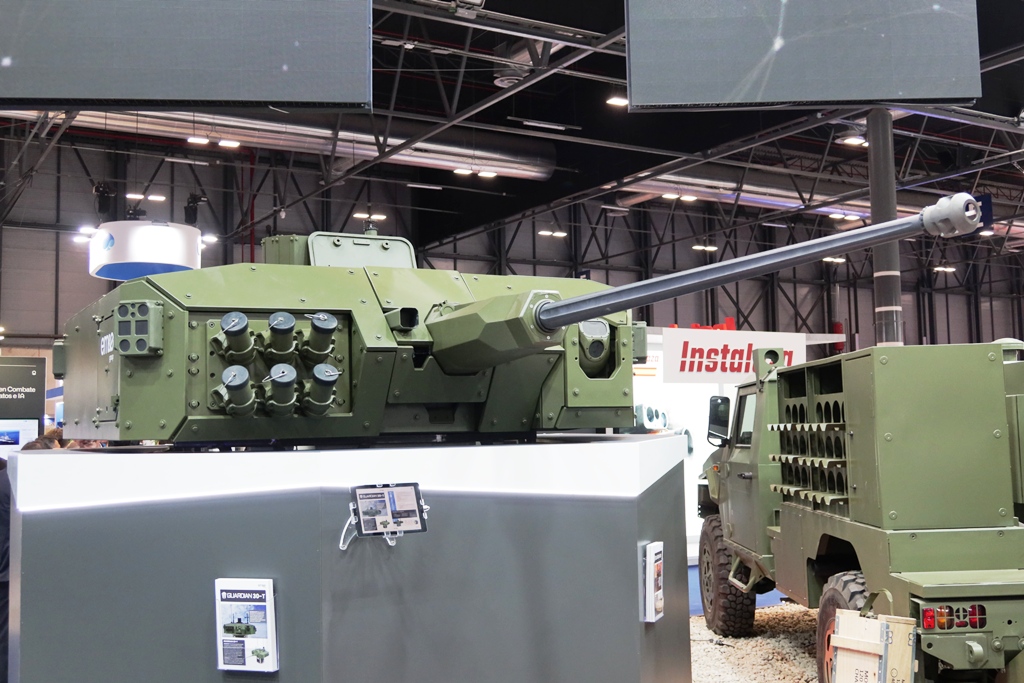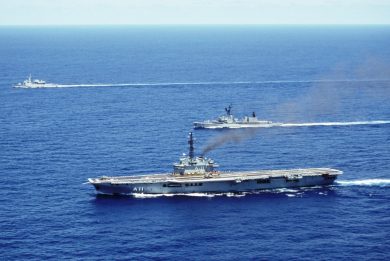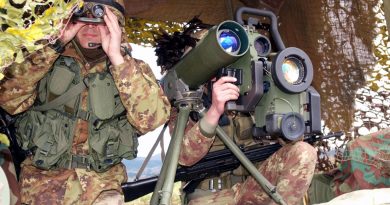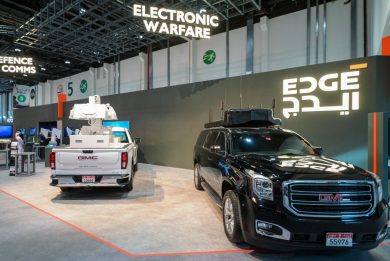
FEINDEF 2025 – Escribano unveils two new turrets, the Guardian 30-T and the Guardian 2.0 PRO, and a mock-up
Two brand new turrets were unveiled by Escribano at the Madrid exhibition, one derived from the well-known Guardian 30, which equips the infantry combat version of the Dragon 8×8, the other from the Guardian 2.0
The Dragon programme, based on the Piranha V 8×8 chassis, includes among its variants the VEC (Vehículo de Exploración de Caballería, cavalry scout vehicle), which main difference with the VCR (Vehículo Blindado de Ruedas, wheeled combat vehicle) is in the turret. For the Dragon programme a temporary association of companies named TESS Defence which includes Indra Sistemas, Santa Bárbara Sistemas, Sapa Operaciones and Escribano M&E, the latter company responsible for the turret.

As said, the difference between the infantry fighting vehicle and the cavalry scout vehicle lies in the turret; the former is fitted with an unmanned turret, the Guardian 30, armed with a Bushmaster II 30 mm turret firing 30×173 mm ammunition, while the second will be fitted with a two-man turret. Although some discussions seem to be ongoing on the opportunity of having such a cumbersome vehicle for the scout role, other nations selected 6×6 platforms, the Spanish Army had shown considerable interest for the Leonardo HITSFIST 30 turret. At FEINDEF 2025 however, Escribano M&E unveiled a two-man version of its Guardian 30, known as Guardian 30-T, showcasing it at the Madrid exhibition.

The new turret shares all the electronics with its unmanned counterpart, most subsystems having the same part numbers, a considerable logistic advantage. The turret is armed with the Bushmaster II MK44/S, for Stretch, which can be upgraded to fire 40 Super Forty rounds. The gun is stabilised on two axes, stabilisation being under 0.2 mrad; its n elevation is between -15° and +60°, a 7.62 mm. A coaxial machine gun is located on the right of the main gun. The commander sits on the right while the gunner is at his left. Moving from the front right and turning around the turret, we first find two rows of three grenade launchers which can be of different type, Wegmann or Galix, or can be replaced by a Rosy launcher. Moving backwards we find a hatch giving access to a stowage compartment, the turret rear area on the right being occupied by a missile launcher, hinged at the rear, which can operate Rafael Spike LR1 or LR2 missiles.

On top of the turret roof, at the rear in the centre we find the commander panoramic sight; at its right we find the meteorological sensors, while on the left we find a Pilar V acoustic gunshot detector (in fact on the prototype seen at FEINDEF the Pilar V was not installed, and the meteo sensor was on the left). Moving to the left. the turret hosts the ammo box, containing 200 ready to fire rounds of two types, respectively 60 and 140, depending on the mission. On the left side a second set of six grenade launchers is installed. Laser warning system detectors are located on the turret corners to ensure 360° coverage.

Moving to the front we find the gunner sight. The two sights are identical; produced by Escribano E&M and known as Apolo. The day channel is based on a CMOS 1920×1080 pixels sensor, fitted with a x30 continuous optical zoom providing a wide field of view of 33.97°x25.25° while the narrow field of view is 1.23°x0.92°. The thermal channel is made of a 3rd generation medium-wave IR Indium antimonide 640×512 pixel sensor with a 15 µm pitch with a x20 continuous zoom providing a wide field of view of 35.5°x26.93° while the narrow field of view is 1.83°x1.38°. Images captured by the two sensors are provided on a 1024×768 pixels colour display. A laser rangefinder operating on the 1550 nm wavelength, with programmable frequency of 1, 3, 5 and 10 Hz, ensures distance measuring up to a maximum range of 15 km, and over 5.5 km on a NATO target, with an accuracy of ± 1 metre.
As both crewmembers have their own sight, the crew can operate in the hunter-killer mode, the commander looking for a target and then assigning it to the gunner while continuing his search. Overall, the Guardian 30-T has a mass of less than 2,900 kg with a Level 4 protection according to STANAG 4569. The turret is ready to be fitted an active protection system, the Trophy or the Iron Fist. Prototypes have already undergone firing trials at the range.

The Guardian 2.0 PRO is a much lighter turret, its dry mass being under 750 kg. An unmanned turret, also stabilised on two axes, stabilisation being under 1 mrad, its main weapon elevation arc goes from 0° to +60°. The turret showcased at FEINDEF was armed with the M230LF gun which uses 30×113 mm ammunition. The Guardian 2.0 PRO can also host a 12.7 mm machine gun or a 40 mm automatic grenade launcher. It is designed to host four Spike antitank missiles, hosted two per side in a launcher which is raised over the turret roof, with two missiles staked one over the other., Two sets of three grenade launchers are fitted on the front side, right and left, a 7.62 mm coaxial machine gun being fitted on the right of the main weapon. On the right we find the Apolo gunner sight, which has identical characteristics of that used on the 30 mm turret.

At FEINDEF the Guardian 2.0 PRO was shown installed on the Ferox 6×6 armoured vehicle, which is bidding for the Spanish Army support vehicle programme, and is developed in cooperation with Nimr, a company of the UAE Edge group. In this configuration the Ferox could host inside the rear compartment at least eigh spare missiles, bringing the total up to 12, a considerable firepower that would definitely make the 6×6 an antitank vehicle capable to hit enemy heavy armour at long distance. Escribano representatives told EDR On-Line that the prototype has already undergone firing tests with the 30 mm gun, while missiles have not yet been launched from the turret. With its new remotely controlled turret Escribano E&M aims also at the VAC (Vehículo de Apoyo a Cadena, tracked support vehicle), a prototype of which was showcased by TESS two years ago at FEINDEF.

Finally, at the static exhibition, an Otokar ARMA 8×8 was equipped with the mock-up of a 120 mm turret fitted with what looked like Apolo sights. How much that turret will become a real product, is to be seen, the Spanish Army having a requirement for an 8×8 heavily armed platform.
Escribano Mechanical & Engineering is increasing its presence in the turret world, both manned and unmanned, and should soon also be producing armoured vehicles, ready to propose itself as a one stop shop for customers needing medium wheeled systems.
Photos by P. Valpolini



